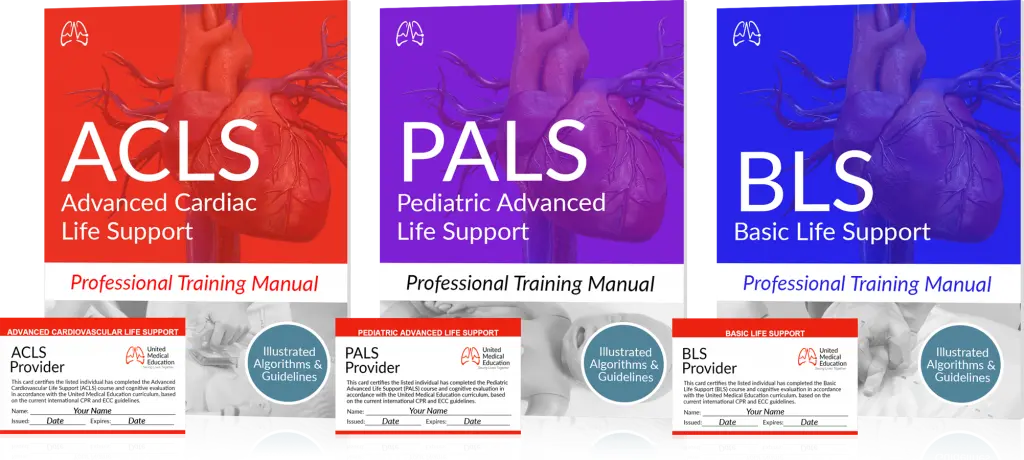PALS certification or Pediatric Advanced Life Support is an advanced resuscitation course for the intervention and recognition of cardiopulmonary arrest or other types of cardiovascular emergencies in pediatric patients. Unlike ACLS and BLS certifications, online PALS certification focuses specifically on providing essential care to injured or critically ill infants and children. PALS is an advanced-level course that builds on the skills that were learned in a BLS provider course. After finishing the course, professionals will gain more knowledge about PALS treatment algorithms, effective pediatric assessment, effective resuscitation, and team dynamics.
Hospital accreditation that is offered by third-party accrediting organizations or by the Joint Commission usually requires specific healthcare professionals to have a PALS certification.
Topics Covered on PALS Course
Hemodynamics
Cardiac/Electrical Therapy
CPR for Children (CABD)
Cardiac Rhythms
CPR for Infants (CABD)
CPR at Birth
Choking Interventions
Tachycardias
Secondary ABCD (Child)
Bradycardias
Airway and Breathing
Asystole
Advanced Airways
Shock
Similar Evidence-Based Training
Learning about the differences between classroom PALS vs. online PALS is critical to make that important decision on which one to take but it would be best to discuss their similarities first.
The PALS algorithms are from the ILCOR Guidelines. ILCOR stands for the International Liaison Committee on Resuscitation which is composed of a board of international medical professionals reviewing procedures and studies to ensure that all recommendations are up-to-date with existing peer-reviewed science.
The majority of online and classroom courses are based on the ILCOR guidelines so students can expect the same up-to-date, accurate and comprehensive information. A test will ensure that a student has gained or retained the lessons from the course on both online and classroom courses. A certificate will only be awarded upon passing the test. This offers the desired validity to the certification.
Online and classroom certifications are both widely accepted for licensure requirements, CME, and employment.
Benefits of Online PALS Over Classroom Setting
Receiving a PALS certification online offers a lot of advantages compared to a classroom-based setting. In today’s world where the Internet provides a lot of benefits, Online PALS certification is no different. The ease of access, availability of learning materials, and the management of study time offers such a huge plus. What’s great is you can obtain a course entirely online that meets the requirements of of PALS certification. Below are the advantages that online PALS training offers any student.
Work at Own Pace
The classroom approach to PALS courses fails to accommodate the variety of learning styles plus experience levels. A student may experience difficulty in fully absorbing the material while in an extremely thorough environment. With a PALS online course, it would be easier to set the pace and decide how to learn.
The flexibility that an online PALS course offers serves as a big plus especially for people who have busy schedules. Students have more control over when to start and stop training at will. This assists in promoting full retention as students can take more time to digest the information at their own pace.
Access from Just About Anywhere
The convenience of accessing online PALS courses at any location offers a huge advantage over traditional learning. The only essential factor required is an internet connection. Online PALS certification can be completed at any location with a good internet connection. It can be accessed without any location restrictions and serves as highly beneficial for busy professionals working in the healthcare industry.
Control Own Schedule
Time is essential to a lot of people and an online PALS course can be easier to fit into any schedule compared to the in-person option. From the start of registration until the completion of the PALS certification, any student can finish an online PALS course without any time restrictions and pace restraints. Having 24/7 access to an online PALS certification offers so many benefits, especially for people who have very busy schedules. This is so ideal for professionals who need to juggle a lot from work, at home, and other aspects of life.
Reduce Repetitiveness and Monotony
Online PALS courses lessen the monotony and repetitiveness that can be experienced in a classroom setting. They help in eliminating time-wasting activities such as learning material that students may already know. Online courses offer people to sign up and even straight up start an exam without the need for any unnecessary instruction. There are also times when a classroom setting promotes boredom or lack of interest and that is a huge disadvantage compared to an Online PALS setting.
Cheaper Option
An online PALS certification is cheaper when the bigger picture is taken into consideration. An in-person PALS course requires additional materials and travel expenses.
Gives Additional Motivation and Lessens Stress
By having the convenience of controlling their own pace, students tend to be more motivated in finishing the course compared to having a traditional setup. Having the option to study during the most productive times can be highly beneficial than when being fed information and yet having a hard time taking them in.
Stress levels are also reduced with an online PALS certification as it offers convenience, access, and more time for students to finish when able.
Number of Hours to Finish Online PALS Certification?
Usually, students complete online PALS certification within 6 to 10 hours. A medical provider such as a nurse, doctor, or EMS professional has a higher chance to run through all the information much quicker compared to someone who is still preparing to enter the medical field.
Continuing Medical Education Credits (CME) Requirement
The requirement for CME is to pass the PALS test with a score of 80% or higher. Take note that a PALS certification is under AMA Category 1 CME. This certification can help in getting 8 CME. For recertification, 4 CME may be obtained.
Who Should Take an Online PALS Certification?
PALS certification is considered an advanced medical certificate. A teacher or a parent who takes care of children would gain a lot of information from this course. However, it should be noted that a PALS certification does not give anyone authority in administering medication or performing anything outside the scope of their professional license. It provides additional information though so that tasks on pediatric patients are performed more properly.
Nurses, physician assistants, physicians, nursing, medical and EMS students, EMTs, paramedics, dental professionals, pharmacists, and any person working in a setting with pediatrics would benefit from the PALS certification program.
How to Find a PALS Course?
Looking for a PALS course does not have to be difficult as the Internet offers instant options with the help of a search button. Expect to get a lot of results for online courses. The convenience of an online PALS course is that anyone can access it from just about anywhere and even use different devices. Any student can study while commuting, at the park, or anywhere convenient.
How to Pick the Right PALS Certification Program?
Picking the right PALS certification program should not be difficult just by performing proper due diligence. Performing additional research before deciding on a specific program is highly essential. Check multiple student reviews to know about their experiences.
Is a Test Required to Get PALS Certified?
Yes, the test helps safeguard the certification program as it should be. A certificate would only be meaningful if it can offer some kind of proof that a course has been completed to acquire additional knowledge. Passing a test and getting certified also helps in providing employers more assurance that an applicant could perform based on the job description and accomplish the steps in the PALS algorithm.
Career Benefits Offered by PALS Certification
PALS offers additional learning of essential skills that can be utilized for pediatric patients and it can also provide benefits for people’s careers. Guarantees are not 100% as employers may have different takes on certifications. However, the benefits listed below are the ones usually experienced by people who acquired their PALS certification.
Licensed Professionals’ Benefits
Having a PALS certification will always provide that additional boost to any resume. Even if an employer does not require this certificate, just having that accolade is already a huge advantage to possibly get the job. The certification offers proof of dedication to children’s well-being.
Having a PALS certification also favors people for promotion over those who do not have one. This is evident in some medical settings.
Students’ Benefits
For students who want to enter their desired program, having a PALS certification helps in providing schools a proof of seriousness about their desired medical career. Showcasing dedication through spending and learning beforehand serves as a relevant factor and schools will appreciate that.
For students fighting for limited spots, a PALS certification could serve as the difference-maker. In addition, PALS courses offer a glimpse of what medical programs tend to be like.
When to Take PALS Recertification?
Upon the expiration of the original PALS certificate, recertification is required after every two years. Healthcare professionals that have the PALS Provider Completion Card would need to pass an exam after undergoing a short refresher course. Whether the course is offline or online, this must include the most up-to-date guidelines.
Difference Between PALS and PEARS
There is a major difference between PALS and PEARS training. The PALS certification assists in teaching students the proper ways to treat critically injured or ill children with the use of advanced life support methods. Training for PALS works best for healthcare providers who frequently attend to seriously injured or ill kids.
Pediatric Emergency Assessment, Recognition and Stabilization or PEARS, on the other hand, focuses on early action until the emergency medical service providers arrive. PEARS is meant for healthcare professionals who infrequently see seriously injured or ill kids.
Difference Between PALS and ACLS
The major difference between PALS and ACLS is the patient who will be receiving the treatment. PALS specifically treat children while ACLS treats adults.
Clinical Outcomes Related to PALS Intervention
Functional Morbidity and Mortality After Use of PALS/APLS
A test was conducted to prove that pediatric shock is a common cause of functional morbidity and death and that PALS/APLS resuscitation in a community hospital setting helps to improve child health outcomes. The study focused on children that were consecutively transported to tertiary care children’s hospitals in 4 years. It was also a prospective cohort study for comparing outcomes between children who received PALS/APLS resuscitation and those who did not in the respective community hospital.
According to the results, 37% of the patients that were moved to the tertiary centers experienced shock. Despite the trauma status, the children with shock showcased an improved mortality rate over those without shock (11.4% vs. 2.6%), trauma patients, and non-trauma patients. The early shock reversal was linked with reduced mortality and functional morbidity rates. The utilization of PALS/APLS-recommended interventions stayed linked with reduced mortality rates and morbidity.
Other Studies Related to PALS
The Efficacy of PALS Training in EMS Providers
PALS helps teach skills that specifically target pediatric resuscitation. A study was conducted to analyze the effect of PALS training among EMS providers. This was for out-of-hospital medical resuscitations and trauma.
A panel of physicians evaluated the EMS run sheets consisting of pediatric medical resuscitations and traumas for 3 years. Among the 183 responses, EMS personnel were the only capable providers of medical stabilization. The entire panel of physicians was unaware of the PALS training status of the EMS squad.
The PALS-trained EMS personnel responded to a total of 36% of all the resuscitations reviewed. There was a significant difference in terms of successful intubations with PALS-trained personnel compared to those without PALS training (85% vs. 48%). A notable difference in the ability to get vascular access in arrest/shock cases was also concluded (100% vs. 70%). The personnel with PALS training had more success in intraosseous line placement compared to those without PALS training (100% vs. 55%). However, it was found out that mortality rates did not differ much between the two groups (37% vs 32%). In conclusion, the study showcased that having PALS training helps in improving procedural skills and has been strongly recommended as part of regular training of all emergency medical service (EMS) personnel.






